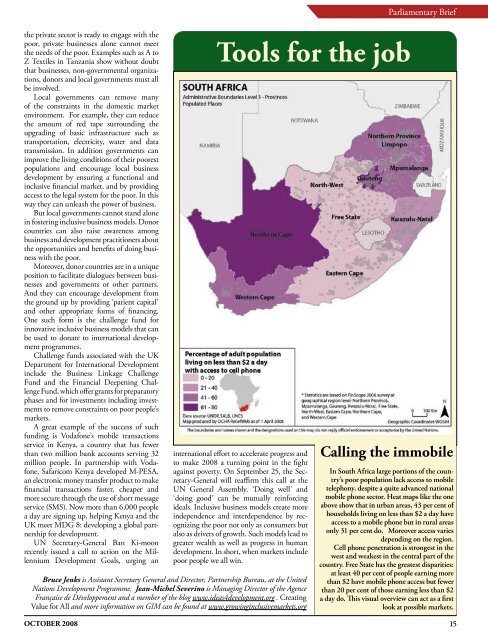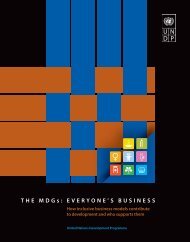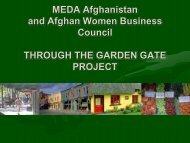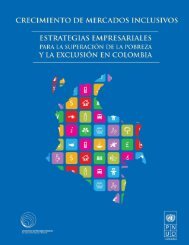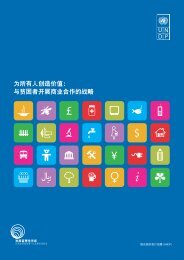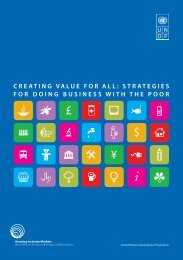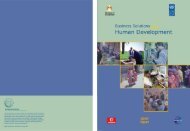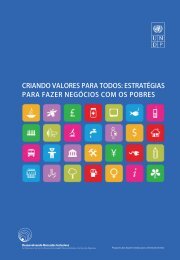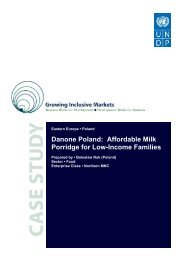Parliamentary Brief14Delivering <strong>the</strong> MDGsThese case studies of companiesfrom across <strong>the</strong> worldshow how <strong>business</strong> can driveprogress <strong>to</strong>ward <strong>the</strong> MDGs.MDG 1: eradicatepoverty and hungerJuan Valdez Café Company, Colombia;CocoTech, PhilippinesJuan Valdex Cafe offers higher, more stableincomes <strong>to</strong> over 500,000 small-scale coffeegrowers. But even smaller-scale projects canhave great repercussions. In <strong>the</strong> Philippines,where coconut farmers are among <strong>the</strong> poorestpeople, CocoTech involves more than 6,000families in cocofibre net production.MDG 2: Universalprimary educationTsinghua Tongfang (THTF), ChinaTHTF markets computers <strong>to</strong> China’s ruralpopulation that include pre-installed distanceeducation software, both for primary andmiddle school education and for minoritylanguage education. The minority languageprogramme’s online video classes, recordedin quality middle schools with minority students,allow THTF’s rural cus<strong>to</strong>mers <strong>to</strong> learnin <strong>the</strong>ir own language.MDG 3: Gender equality and<strong>the</strong> empowerment of womenForus Bank, RussiaFinancial institutions can increase access<strong>to</strong> finance — an important need for <strong>the</strong>many women micro-entrepreneurs in developingcountries. In Russia, over 80 per cen<strong>to</strong>f Forus Bank’s clients are women, most of<strong>the</strong>m in retail <strong>business</strong>es; in 2006 <strong>the</strong> bankhelped create 4,250 direct and 19,950 indirectjobs.MDG 4: Reducechild mortalityPesinet, Mali and SenegalIn Mali, where in 2000 more than 22 percent of infants died before <strong>the</strong>ir first birthday,Pésinet is making a difference in <strong>the</strong> communitieswhere it operates by providing an earlywarning method for moni<strong>to</strong>ring <strong>the</strong> healthconditions of children under age five fromlow-income families. In Saint Louis, Senegal,where Pésinet started, <strong>the</strong> infant mortalityrate fell by more than 90 per cent between2002 and 2005 from 120 per 1,000 livebirths <strong>to</strong> eight per 1,000.MDG 5: Improve maternalhealthVidaGas, MozambiqueThe liquefied petroleum gas providedby VidaGas <strong>to</strong> clinics in Cabo Delgadoimproves <strong>the</strong> sterility of medical instrumentsused <strong>to</strong> deliver babies. Where most publicclinics were once short of essential drugs, andmost maternal deaths resulted from infectionand hemorrhage caused by complications inpregnancy, <strong>to</strong>day’s reliable fuel supply, coldchain for medicines and better distributionof medicines all improve maternal health.MDG 6: Combat HIV/AIDS,malaria and o<strong>the</strong>r diseasesA <strong>to</strong> Z Textile Mills, TanzaniaA <strong>to</strong> Z provide affordable, long-lastinginsecticide-treated bed nets that preventmosqui<strong>to</strong>es from spreading malaria, reducingdeaths by 50 per cent. The success ofthis enterprise lies in its extensive privatepublicpartnerships. Sumi<strong>to</strong>mo, a Japanesecompany, transfers technology and chemicals<strong>to</strong> A <strong>to</strong> Z through a loan from AcumenFund. A <strong>to</strong> Z <strong>the</strong>n buys resin for <strong>the</strong> netsfrom ExxonMobil, which donates funds <strong>to</strong>UNICEF <strong>to</strong> buy <strong>the</strong> treated nets for <strong>the</strong> mostvulnerable children.MDG 7: Create <strong>the</strong> basicconditions of decent housingA South African bank supported by <strong>the</strong>Agence Française de Développement (AFD)is increasing <strong>the</strong> number of its social housingprojects, <strong>targe</strong>ting a growing number of <strong>the</strong>poorest households through <strong>the</strong> payment ofan intermediary aid subsidy. It exemplifies<strong>the</strong> type of <strong>business</strong> model that includes <strong>the</strong>poor and offers gain for all.MDG 8: Develop a globalpartnership for developmentSmart, <strong>the</strong> PhilippinesSmart is reducing <strong>the</strong> ‘digital divide’ andhelping develop a partnership for developmentby providing low-cost, prepaid mobilephone airtime cards. It also eases financialtransactions by providing <strong>the</strong> option <strong>to</strong>send remittances using technology. Witha network covering over 99 per cent of <strong>the</strong>population, Smart’s focus on <strong>the</strong> low-incomemarket enables it <strong>to</strong> serve 24.2 millionpeople. In 2003, Smart was <strong>the</strong> year’s mostprofitable of <strong>the</strong> 5,000 largest corporations in<strong>the</strong> Philippines.and for <strong>the</strong> poor <strong>the</strong>mselves. These are:limited market information, ineffective regula<strong>to</strong>ryenvironments, inadequate physicalinfrastructure, missing knowledge and skills,and restricted access <strong>to</strong> financial productsand services.To overcome <strong>the</strong>se constraints takes creativityfrom and co-operation between manyac<strong>to</strong>rs. In <strong>the</strong> report we note five of <strong>the</strong> mostconsistent and effective strategies: <strong>to</strong> adaptproducts and processes, <strong>to</strong> invest in trainingor infrastructure <strong>to</strong> remove constraints, <strong>to</strong>leverage <strong>the</strong> strengths of <strong>the</strong> poor <strong>to</strong> increaselabour and management pools and <strong>to</strong> expandlocal knowledge, <strong>to</strong> engage in policy dialogueswith governments, and <strong>to</strong> work withsimilarly-minded <strong>business</strong>es, non-profi<strong>to</strong>rganizations or public service providers.By using a more inclusive <strong>business</strong>model <strong>business</strong>es drive innovation, developnew markets, enlarge <strong>the</strong> labour pool andstreng<strong>the</strong>n supply chains, and at <strong>the</strong> sametime are helping <strong>the</strong> poor <strong>to</strong> meet <strong>the</strong>ir basic<strong>needs</strong>, increasing <strong>the</strong>ir incomes and empowering<strong>the</strong>m.Moreover, <strong>business</strong> with <strong>the</strong> poor can beprofitable, sometimes even more profitablethan more traditional <strong>business</strong>es. The NarayanaHrudayalaya (NH) hospital group, acardiac health care provider <strong>to</strong> <strong>the</strong> poor inIndia, uses a <strong>business</strong> model that attractsfull-price paying patients who, along with<strong>the</strong> NH foundation, subsidize surgeries for<strong>the</strong> poor. No one is denied health care even if<strong>the</strong>y are unable <strong>to</strong> pay.Yet profits are 20 per cent — higher than<strong>the</strong> leading comparable traditional hospital.Such financial self-sustainability allowsenterprises like NH <strong>to</strong> increase <strong>the</strong>ir reachand thus <strong>the</strong>ir impact, particularly withregard <strong>to</strong> achieving MDGs.A closer look at several of <strong>the</strong> case studiesdemonstrates <strong>the</strong> direct impact inclusive<strong>business</strong> models have on <strong>the</strong> MDGs (seeDelivering <strong>the</strong> MDGs, left, <strong>to</strong> discover howcompanies from across <strong>the</strong> globe are using<strong>business</strong> acumen with a social conscience <strong>to</strong>create drivers of MDGs in <strong>the</strong>ir local communities).Creating Value for All, by presenting<strong>the</strong>se case studies, is intended <strong>to</strong> encourage<strong>the</strong> development of more inclusive <strong>business</strong>models like <strong>the</strong>se. It also presents practical<strong>to</strong>ols <strong>to</strong> enable <strong>business</strong>es <strong>to</strong> see this through.One <strong>to</strong>ol is <strong>the</strong> strategy matrix, which isdesigned <strong>to</strong> help identify market constraintsand also <strong>to</strong> look at various strategies <strong>to</strong>address <strong>the</strong>m. Ano<strong>the</strong>r effective <strong>to</strong>ol consistsof so-called ‘heat maps’, which identify<strong>business</strong> opportunities by visually presentinggeographical overviews of access <strong>to</strong> water,credit, electricity or telephone service for specificregions; see Tools for <strong>the</strong> job (page right)for a more detailed example.Even when <strong>the</strong>se <strong>to</strong>ols are employed andOCTOBER 2008
<strong>the</strong> private sec<strong>to</strong>r is ready <strong>to</strong> engage with <strong>the</strong>poor, private <strong>business</strong>es alone cannot meet<strong>the</strong> <strong>needs</strong> of <strong>the</strong> poor. Examples such as A <strong>to</strong>Z Textiles in Tanzania show without doubtthat <strong>business</strong>es, non-governmental organizations,donors and local governments must allbe involved.Local governments can remove manyof <strong>the</strong> constraints in <strong>the</strong> domestic marketenvironment. For example, <strong>the</strong>y can reduce<strong>the</strong> amount of red tape surrounding <strong>the</strong>upgrading of basic infrastructure such astransportation, electricity, water and datatransmission. In addition governments canimprove <strong>the</strong> living conditions of <strong>the</strong>ir poorestpopulations and encourage local <strong>business</strong>development by ensuring a functional andinclusive financial market, and by providingaccess <strong>to</strong> <strong>the</strong> legal system for <strong>the</strong> poor. In thisway <strong>the</strong>y can unleash <strong>the</strong> power of <strong>business</strong>.But local governments cannot stand alonein fostering inclusive <strong>business</strong> models. Donorcountries can also raise awareness among<strong>business</strong> and development practitioners about<strong>the</strong> opportunities and benefits of doing <strong>business</strong>with <strong>the</strong> poor.Moreover, donor countries are in a uniqueposition <strong>to</strong> facilitate dialogues between <strong>business</strong>esand governments or o<strong>the</strong>r partners.And <strong>the</strong>y can encourage development from<strong>the</strong> ground up by providing ‘patient capital’and o<strong>the</strong>r appropriate forms of financing.One such form is <strong>the</strong> challenge fund forinnovative inclusive <strong>business</strong> models that canbe used <strong>to</strong> donate <strong>to</strong> international developmentprogrammes.Challenge funds associated with <strong>the</strong> UKDepartment for International Developmentinclude <strong>the</strong> Business Linkage ChallengeFund and <strong>the</strong> Financial Deepening ChallengeFund, which offer grants for prepara<strong>to</strong>ryphases and for investments including investments<strong>to</strong> remove constraints on poor people’smarkets.A great example of <strong>the</strong> success of suchfunding is Vodafone’s mobile transactionsservice in Kenya, a country that has fewerthan two million bank accounts serving 32million people. In partnership with Vodafone,Safaricom Kenya developed M-PESA,an electronic money transfer product <strong>to</strong> makefinancial transactions faster, cheaper andmore secure through <strong>the</strong> use of short messageservice (SMS). Now more than 6,000 peoplea day are signing up, helping Kenya and <strong>the</strong>UK meet MDG 8: developing a global partnershipfor development.UN Secretary-General Ban Ki-moonrecently issued a call <strong>to</strong> action on <strong>the</strong> MillenniumDevelopment Goals, urging anTools for <strong>the</strong> jobinternational effort <strong>to</strong> accelerate progress and<strong>to</strong> make 2008 a turning point in <strong>the</strong> fightagainst poverty. On September 25, <strong>the</strong> Secretary-Generalwill reaffirm this call at <strong>the</strong>UN General Assembly. ‘Doing well’ and‘doing good’ can be mutually reinforcingideals. Inclusive <strong>business</strong> models create moreindependence and interdependence by recognizing<strong>the</strong> poor not only as <strong>consumer</strong>s butalso as drivers of growth. Such models lead <strong>to</strong>greater wealth as well as progress in humandevelopment. In short, when markets includepoor people we all win.Bruce Jenks is Assistant Secretary General and Direc<strong>to</strong>r, Partnership Bureau, at <strong>the</strong> UnitedNations Development Programme. Jean-Michel Severino is Managing Direc<strong>to</strong>r of <strong>the</strong> AgenceFrançaise de Développement and a member of <strong>the</strong> blog www.ideas4development.org . CreatingValue for All and more information on GIM can be found at www.growinginclusivemarkets.orgParliamentary BriefCalling <strong>the</strong> immobileIn South Africa large portions of <strong>the</strong> country’spoor population lack access <strong>to</strong> mobiletelephony, despite a quite advanced nationalmobile phone sec<strong>to</strong>r. Heat maps like <strong>the</strong> oneabove show that in urban areas, 43 per cent ofhouseholds living on less than $2 a day haveaccess <strong>to</strong> a mobile phone but in rural areasonly 31 per cent do. Moreover access variesdepending on <strong>the</strong> region.Cell phone penetration is strongest in <strong>the</strong>west and weakest in <strong>the</strong> central part of <strong>the</strong>country. Free State has <strong>the</strong> greatest disparities:at least 40 per cent of people earning morethan $2 have mobile phone access but fewerthan 20 per cent of those earning less than $2a day do. This visual overview can act as a firstlook at possible markets.OCTOBER 2008 15


